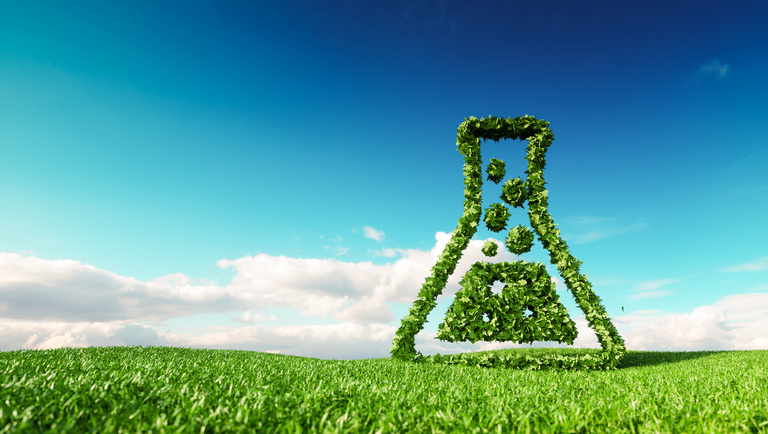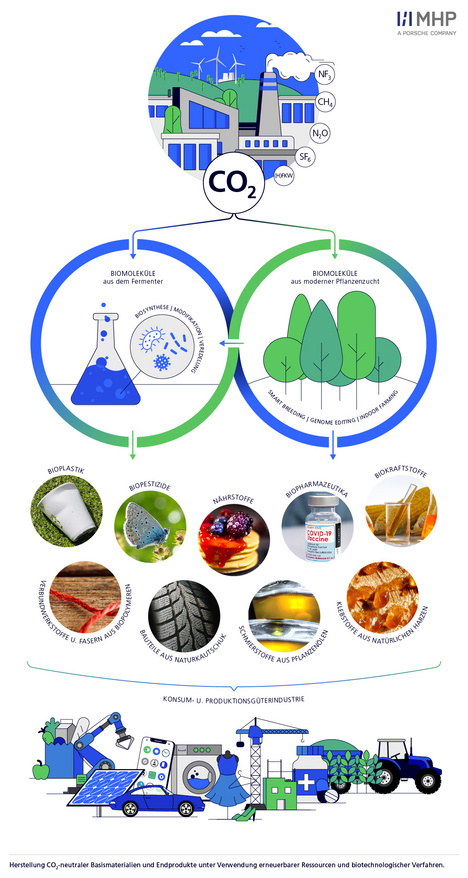
- Blog
- Published on: 20.04.2023
- 3:35 mins
How Biotechnology Can Create Zero Impact Products
Using Organisms to Recycle CO2
Global warming and the burden on the environment, scarce resources and social grievances – all these are extremely good reasons for making your company sustainable. Against this backdrop, Zero Impact Products are likely to be the main goal for the vast majority of producers. The crucial question is how companies can shape product development and product manufacturing processes and create the resulting products without causing negative environmental effects.
A valid answer to this is the use of biotechnology! Along to Green Tech based on digital technologies, this is another factor that plays a key role in the transformation to a sustainable world. The technical application of biological systems and the use of renewable resources not only reduces new emissions, but also recycles the critical legacy emissions, i.e. CO2 that has already been introduced into the atmosphere. Biotechnology includes, for example, the production of biofuels by means of microorganisms or the cultivation of plants that are more resistant to pests and diseases and require fewer pesticides. These and similar approaches are instrumental in reducing the use of fossil fuels and petrochemical processes. Biotechnology is therefore a crucial factor in advancing defossilization and significantly helps to achieve carbon neutrality as a core element of future-oriented product development and product manufacturing processes.
“Product Development Process” Dimension
In product development processes, both the choice of the correct raw materials and corresponding process optimizations are crucial to minimizing the Product Carbon Footprint. Biotechnological processes play an important role in this dimension of circular business models. By intelligently using renewable resources to produce materials – from raw materials to final products – it is possible to optimize the intrinsic recyclability and biodegradability of products so that they no longer pose an environmental burden during and after their useful life.
- Degradability: Products should be biodegradable to keep the environmental impact low. However, there is an unfavorable relationship between biodegradability and CO2 emissions, as CO2 is also released when products are decomposed by microorganisms.
- Longer product life: This results in CO2 being kept bound for a longer period of time. It is important to take advantage of the benefits of biodegradability, but at the same time to also factor in the effects on the carbon balance and to take measures to reduce emissions.
- Reusability/recyclate content: Resources should be used that can be easily recovered and therefore best integrated into a circular economy. Plants are a prime example of renewable resources in sustainable product development, as they convert atmospheric CO2 into base materials: Cellulose and lignin for components, resins for bonding, oils for lubricating, and natural rubber for tire production. To influence and increase the diversity of the base materials, biotechnology also offers the option of using microorganisms and biotransformation processes. These can directly or indirectly convert CO2 into raw materials, which can in turn be used as biofuel or for biopolymer synthesis. This means that a neutral Product Carbon Footprint can be achieved by removing CO2 from the atmosphere and effectively storing it over a long product life.
“Product Manufacturing Process” Dimension
In order to make manufacturing processes sustainable, it is necessary to handle chemical substances responsibly. Avoiding the use of hazardous chemicals is a key factor in protecting health and the environment. Biotechnological processes and renewable resources are an important prerequisite for sustainable production because they offer more environmentally friendly alternatives to chemical processes and raw materials. Although establishing biotechnological processes at scale can require large initial investments, such processes often offer a price advantage over the use of expensive chemicals in the long term.
Development and Manufacturing Challenges
When integrating biotechnological approaches into the product development and product manufacturing process, it is important to consider:
- Developing the required skillsets in the company must be ensured via internal or external means.
- The required technologies for processing and recovering bioresources must be optimized where necessary.
- The selection of suitable materials must be based on renewable resources.
- The scale at which the technologies and processes are used must be optimized based on the location (in terms of energy, resource availability, supply chain, etc.).
- To be feasible in practice, biotechnological solutions must not only be sustainable, but also economically viable.
- Existing regulations must be adhered to but can also be seen as opportunities. Stricter regulations, such as the German Fuel Emission Allowance Trading Act, impose radical, disruptive, and costly measures to implement or achieve climate goals. Public funding is often provided for this purpose.
Finally, we recommend that companies that want to produce their products in a more sustainable manner and remain in a competitive position in the future incorporate biotechnological processes and materials more effectively into their product planning where it is feasible and appropriate to do so. This, in addition to supply chain optimization, can significantly increase the positive impact on the Product Carbon Footprint that can be achieved in the two dimensions of product development and product manufacturing.
Please contact us if you are interested in discussing the biotechnological potentials for your company.




